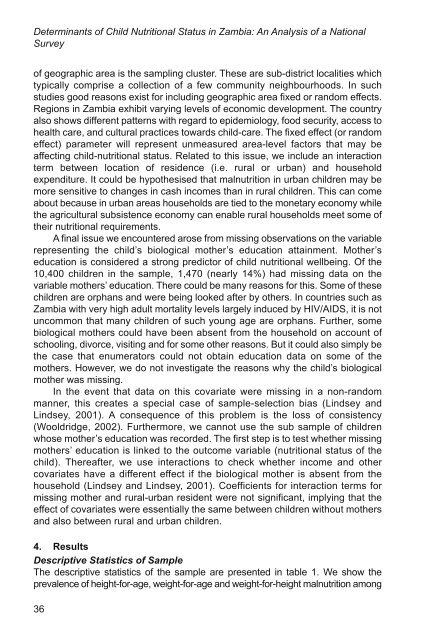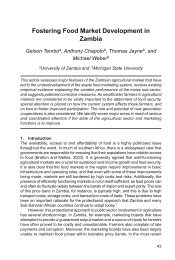Determinants of Child Nutritional Status in Zambia - Access-to-law.com
Determinants of Child Nutritional Status in Zambia - Access-to-law.com
Determinants of Child Nutritional Status in Zambia - Access-to-law.com
You also want an ePaper? Increase the reach of your titles
YUMPU automatically turns print PDFs into web optimized ePapers that Google loves.
<strong>Determ<strong>in</strong>ants</strong> <strong>of</strong> <strong>Child</strong> <strong>Nutritional</strong> <strong>Status</strong> <strong>in</strong> <strong>Zambia</strong>: An Analysis <strong>of</strong> a National<br />
Survey<br />
<strong>of</strong> geographic area is the sampl<strong>in</strong>g cluster. These are sub-district localities which<br />
typically <strong>com</strong>prise a collection <strong>of</strong> a few <strong>com</strong>munity neighbourhoods. In such<br />
studies good reasons exist for <strong>in</strong>clud<strong>in</strong>g geographic area fixed or random effects.<br />
Regions <strong>in</strong> <strong>Zambia</strong> exhibit vary<strong>in</strong>g levels <strong>of</strong> economic development. The country<br />
also shows different patterns with regard <strong>to</strong> epidemiology, food security, access <strong>to</strong><br />
health care, and cultural practices <strong>to</strong>wards child-care. The fixed effect (or random<br />
effect) parameter will represent unmeasured area-level fac<strong>to</strong>rs that may be<br />
affect<strong>in</strong>g child-nutritional status. Related <strong>to</strong> this issue, we <strong>in</strong>clude an <strong>in</strong>teraction<br />
term between location <strong>of</strong> residence (i.e. rural or urban) and household<br />
expenditure. It could be hypothesised that malnutrition <strong>in</strong> urban children may be<br />
more sensitive <strong>to</strong> changes <strong>in</strong> cash <strong>in</strong><strong>com</strong>es than <strong>in</strong> rural children. This can <strong>com</strong>e<br />
about because <strong>in</strong> urban areas households are tied <strong>to</strong> the monetary economy while<br />
the agricultural subsistence economy can enable rural households meet some <strong>of</strong><br />
their nutritional requirements.<br />
A f<strong>in</strong>al issue we encountered arose from miss<strong>in</strong>g observations on the variable<br />
represent<strong>in</strong>g the child’s biological mother’s education atta<strong>in</strong>ment. Mother’s<br />
education is considered a strong predic<strong>to</strong>r <strong>of</strong> child nutritional wellbe<strong>in</strong>g. Of the<br />
10,400 children <strong>in</strong> the sample, 1,470 (nearly 14%) had miss<strong>in</strong>g data on the<br />
variable mothers’ education. There could be many reasons for this. Some <strong>of</strong> these<br />
children are orphans and were be<strong>in</strong>g looked after by others. In countries such as<br />
<strong>Zambia</strong> with very high adult mortality levels largely <strong>in</strong>duced by HIV/AIDS, it is not<br />
un<strong>com</strong>mon that many children <strong>of</strong> such young age are orphans. Further, some<br />
biological mothers could have been absent from the household on account <strong>of</strong><br />
school<strong>in</strong>g, divorce, visit<strong>in</strong>g and for some other reasons. But it could also simply be<br />
the case that enumera<strong>to</strong>rs could not obta<strong>in</strong> education data on some <strong>of</strong> the<br />
mothers. However, we do not <strong>in</strong>vestigate the reasons why the child’s biological<br />
mother was miss<strong>in</strong>g.<br />
In the event that data on this covariate were miss<strong>in</strong>g <strong>in</strong> a non-random<br />
manner, this creates a special case <strong>of</strong> sample-selection bias (L<strong>in</strong>dsey and<br />
L<strong>in</strong>dsey, 2001). A consequence <strong>of</strong> this problem is the loss <strong>of</strong> consistency<br />
(Wooldridge, 2002). Furthermore, we cannot use the sub sample <strong>of</strong> children<br />
whose mother’s education was recorded. The first step is <strong>to</strong> test whether miss<strong>in</strong>g<br />
mothers’ education is l<strong>in</strong>ked <strong>to</strong> the out<strong>com</strong>e variable (nutritional status <strong>of</strong> the<br />
child). Thereafter, we use <strong>in</strong>teractions <strong>to</strong> check whether <strong>in</strong><strong>com</strong>e and other<br />
covariates have a different effect if the biological mother is absent from the<br />
household (L<strong>in</strong>dsey and L<strong>in</strong>dsey, 2001). Coefficients for <strong>in</strong>teraction terms for<br />
miss<strong>in</strong>g mother and rural-urban resident were not significant, imply<strong>in</strong>g that the<br />
effect <strong>of</strong> covariates were essentially the same between children without mothers<br />
and also between rural and urban children.<br />
4. Results<br />
Descriptive Statistics <strong>of</strong> Sample<br />
The descriptive statistics <strong>of</strong> the sample are presented <strong>in</strong> table 1. We show the<br />
prevalence <strong>of</strong> height-for-age, weight-for-age and weight-for-height malnutrition among<br />
36




